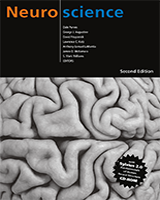From: Formation of the Major Brain Subdivisions
NCBI Bookshelf. A service of the National Library of Medicine, National Institutes of Health.
Purves D, Augustine GJ, Fitzpatrick D, et al., editors. Neuroscience. 2nd edition. Sunderland (MA): Sinauer Associates; 2001.

Neuroscience. 2nd edition.
Show detailsBox CRhombomeres
An interesting parallel between early embryonic segmentation and early brain development was noticed around the turn of the nineteenth century. Several embryologists reported repeating units in the early neural plate and neural tube, which they called neuromeres. In the late 1980s, A. Lumsden, R. Keynes, and their colleagues, as well as R. Krumlauf, R. Wilkinson, and colleagues, noticed further that combinations of homeobox (Hox) genes (see Box B) are expressed in banded patterns in the developing chick nervous system, especially in the hindbrain (the common name for the rhombencephalon and its derivatives). These Hox expression domains defined rhombomeres, which in the chick (as well as in most mammals), are a series of seven transient bulges in the developing rhombencephalon corresponding to the neuromeres described earlier. Rhombomeres are sites of differential cell proliferation (cells at rhombomere boundaries divide faster than cells in the rest of the rhombomere), differential cell mobility (cells from any one rhombomere cannot easily cross into adjacent rhombomeres), and differential cell adhesion (cells prefer to stick to those of their own rhombomere).
Later in development, the pattern of axon outgrowth from the cranial motor nerves also correlates with the earlier rhombomeric pattern. Cranial motor nerves (see Chapter 1) originate either from a single rhombomere or from specific pairs of neighboring rhombomeres (transplantation experiments indicate that rhombomeres are in fact specified in pairs). Thus, Hox gene expression probably represents an early step in the formation of cranial nerves in the developing brain. Mutation or ectopic activation of Hox genes in mice alters the position of specific cranial nerves, or prevents their formation. Mutation of the HoxA-1 gene by homologous recombination—the so-called “knockout” strategy for targeting mutations to specific genes—prevents normal formation of rhombomeres. In these animals, development of the external, middle, and inner ear is also compromised, and cranial nerve ganglia are fused and located incorrectly. Conversely, when the HoxA-1 gene is expressed in a rhombomere where it is usually not seen, the ectopic expression causes changes in rhombomere identity and subsequent differentiation. It is likely that problems in rhombomere formation are the underlying cause of congenital nervous system defects involving cranial nerves, ganglia, and peripheral structures derived from the cranial neural crest (the part of the neural crest that arises from the hindbrain).
The exact relationship between early patterns of rhombomere-specific gene transcription and subsequent cranial nerve development remains a puzzle. Nevertheless, the correspondence between these repeating units in the embryonic brain and similar iterated units in the development of the insect body (see Figure 22.5) suggests that differential expression of transcription factors in specific regions is essential for the normal development of many species. In a wide variety of animals, spatially and temporally distinct patterns of transcription factor expression coincide with spatially and temporally distinct patterns of differentiation, including the differentiation of the nervous system. The idea that the bulges and folds in the neural tube are segments defined by patterns of gene expression provides an attractive framework for understanding the molecular basis of pattern formation in the developing vertebrate brain.

Rhombomeres in the developing chicken hindbrain and their relationship to the differentiation of the cranial nerves. (A) Diagram of the chick hindbrain, indicating the position of the cranial ganglia and nerves and their rhombomeric origin (rhombomeres denoted as r1 to r7). (B) Section through early chicken hindbrain, showing bulges that will eventually become rhombomeres (in this example, r3 to r5). (C) Differential patterns of transcription factor expression (in this case, krx 20, a Hox-like gene) define rhombomeres at early stages of development, well before the cranial nerves that will eventually emerge from them are apparent. (A courtesy of Andrew Lumsden; B,C from Wilkinson and Krumlauf, 1990.)
References
- Guthrie S. Patterning the hindbrain. Curr. Opin. Neurobiol. (1996);6:41–48. [PubMed: 8794049]
- Carpenter E. M. , Goddard J. M. , Chisaka O. , Manley N. R. , Capecchi M. Loss of HoxA-1 (Hox-1.6) function results in the reorganization of the murine hindbrain. Develop. (1993);118:1063–1075. [PubMed: 7903632]
- Lumsden A. , Keynes R. Segmental patterns of neuronal development in the chick hindbrain. Nature. (1989);337:424–428. [PubMed: 2644541]
- Wilkinson D. G. , Krumlauf R. Molecular approaches to the segmentation of the hindbrain. Trends Neurosci. (1990);13:335–339. [PubMed: 1699319]
- Von Kupffer, K. (1906) Die morphogenie des central nerven systems. In Handbuch der vergleichende und experiementelle Entwicklungslehreder Wirbeltiere, Vol. 2, 3: 1–272. Fischer Verlag, Jena.
- Zhang M. , 9 Others Ectopic HoxA-1 induces rhombomere transformation in mouse hindbrain. Develop. (1993);120:2431–2442. [PubMed: 7956823]
- PubMedLinks to PubMed
- Box C, Rhombomeres - NeuroscienceBox C, Rhombomeres - Neuroscience
Your browsing activity is empty.
Activity recording is turned off.
See more...